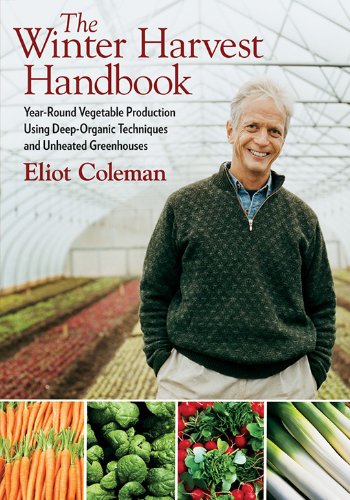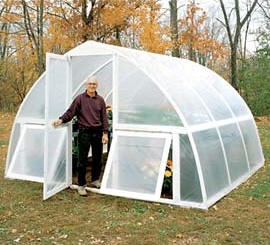Updated: December 3, 2020
Let’s take a sec to get the legal words out of the way. This article may contain affiliate links. That means if you click and buy from my partners, I will make a tiny amount of money at no cost to you. This in no way affects my recommendations.
In the depths of winter, there may be no better “read” for an enthusiastic backyard gardener than The Winter Harvest Handbook by Eliot Coleman. It’s the king of books on year-round vegetable growing.
Coleman is the master of “using deep-organic techniques and unheated greenhouses for year-round vegetable production.”
He surprises the reader by showing how to grow vegetables with no external heat source during Maine’s cold winters.
Most gardening enthusiasts will read the cover and want to know: How does he do that?
My big mistake was not picking a raised bed that got enough sun in the winter months.
— Suburban Hobby Farmer
Maybe the most astounding point in the Handbook is that you can magically transport your garden 500 miles, or three USDA zones, to the south by adding a hoop house and row covers.
Easy, inexpensive, healthy and flavorful
The guiding principles of Coleman’s Handbook are “simplicity, low external input, and high quality output’s.” That’s another way of saying food production should be easy, inexpensive, healthy and flavorful, which is in line with the premise of the Suburban Hobby Farmer blog.

The Winter Harvest Handbook
You can magically transport your garden 500 miles, or three USDA zones, to the south by adding a hoop house and row covers.
Based on his inspiration and some of his principles, I made my first attempt at cold house gardening 10 years ago.
Using a very small, hand-made hoop house and an inexpensive cold frame I had purchased a year earlier, I grew lettuce, arugula, radishes and beets in my southern New Hampshire backyard.
Related: A Hoop House is a Tomato Growing Machine
The arugula came out best. Followed by the radishes. I had much more difficulty with the others.
This was probably because I didn’t follow some of Coleman’s key points.
My big mistake was not picking a raised bed that got enough sun in the winter months. The one I selected got plenty of sun in late spring and summer, but not enough sun in the late fall and winter.
Winter Harvest Handbook, growing arugula
But the arugula I grew was pretty interesting. Even if you compared it to arugula from the same seeds grown in spring, this was different.
When you put it in your mouth and began chewing it, the taste started off buttery and a little bit sweet. But at the very end, just before you swallowed it, the taste grew very strong, almost bitter.
Timing of planting is very important if you want to successfully harvest in winter.
— Eliot Coleman
It was like no salad green I had tasted before. Certainly, it was more flavorful any other salad green I had ever grown.
I wouldn’t say it was the best I’ve grown, but it amazed me that growing the same plant at a different time of year could result in such taste difference.
Coleman grows arugula, but also radishes, turnips, turnip greens, Swiss chard, watercress, and parsley in the cool house during the winter months.
Related: Grow a Million Cucumbers in a Hoop House
In order to be successful with most of his crops, he carefully times his plantings because most crops must reach a certain minimum size before the day length drops below the 10-hour mark.
In other words, timing is very important if you want to successfully harvest in winter.
Exacting and detail-oriented
Backyard gardeners may be put off by Coleman’s exacting and detail-oriented nature. After all, he is a professional farmer and not a backyard gardener.
For example, he takes extreme pleasure in getting his tools just right. “Stop considering the tool you have [as] a finished product [but] rather consider it as a point of departure.”
In other words, don’t be satisfied with the farming tool you have, keep making it better.
This may go too far for some of SHF’s readers. If you’re the kind of hobbyist that throws a few seeds in the ground, adds store bought compost and waters when needed, this book is not for you.
Keep in mind, gardening in the cold of late fall and winter is no day at the beach. You have to really enjoyed it to be out there when the mercury dips below 50°.
But, on the other hand, wow! Fresh salad in January. My guess is some of you will want to try.
The bottom line is if you use what Coleman has learned to extend your growing season a month earlier in spring and a month later in fall, it’s well worth the price of the paperback.
It’s worth the investment for the enjoyment, better health and maybe even the savings on vegetables.
Finally, Coleman has the right sprit for Suburban Hobby Farmer’s readers. He says, “farmers should always share ideas with each other.”
Related articles you might enjoy:
- Another Eliot Coleman Book: Four-season Harvest
- I Shopped for Hoop House Kits. This is the One I Bought
- How to Grow Lettuce in Winter
Suburban Hobby Farmer is a participant in the Amazon Services LLC Associates Program, an affiliate advertising program designed to provide a means for sites to earn advertising fees by advertising and linking to amazon.com.
